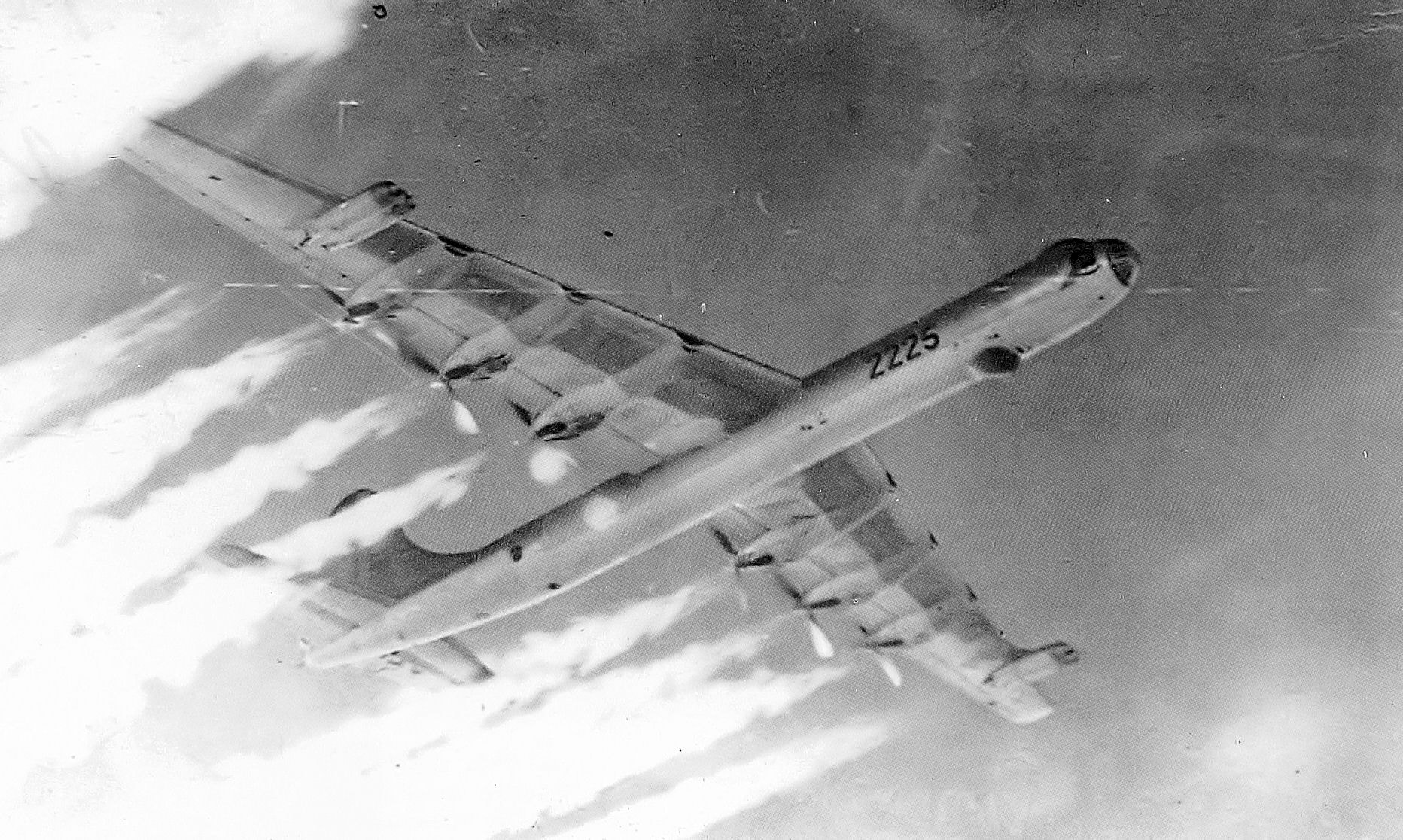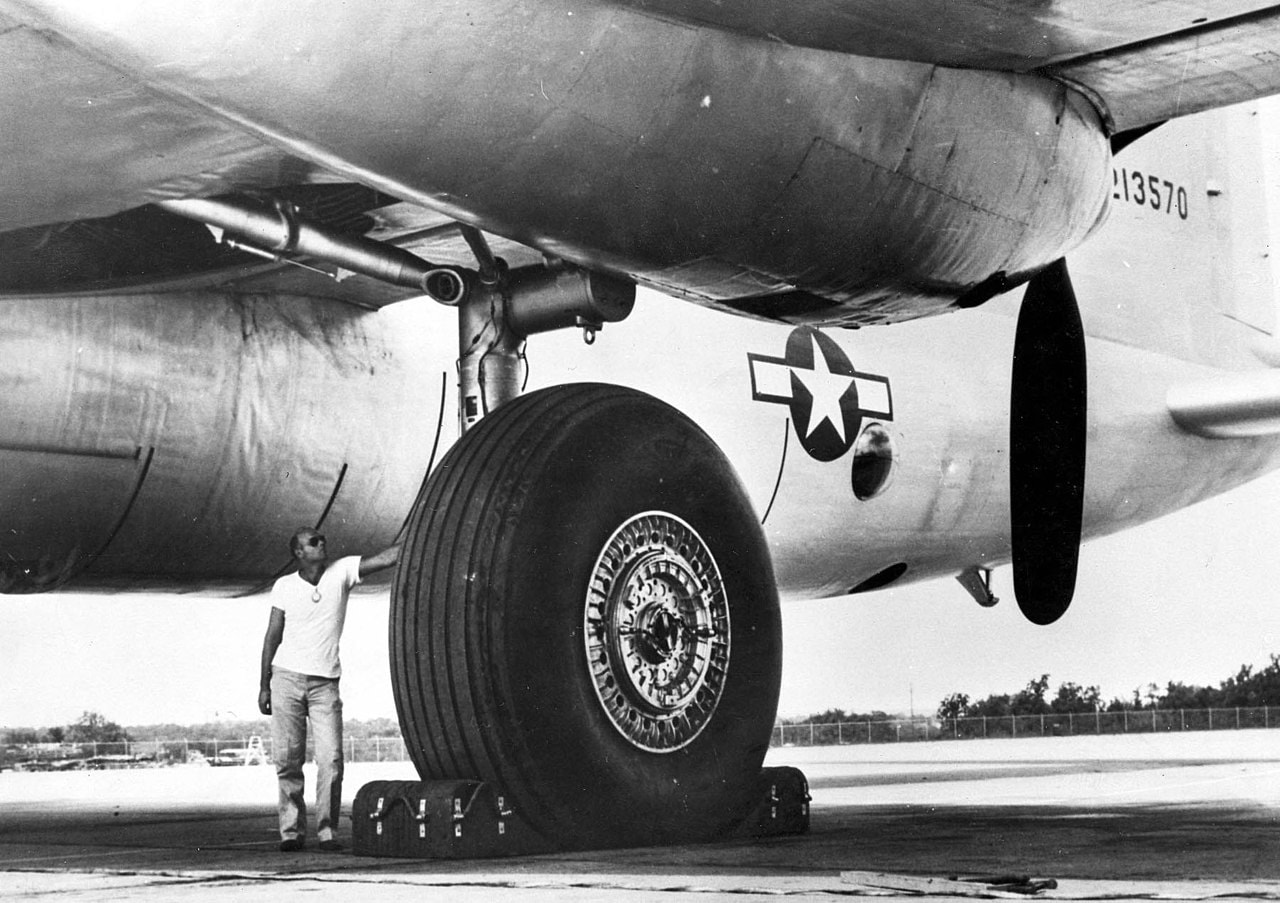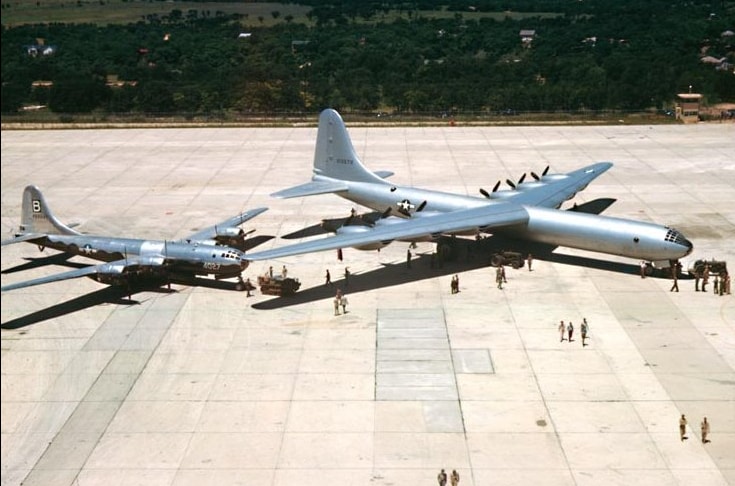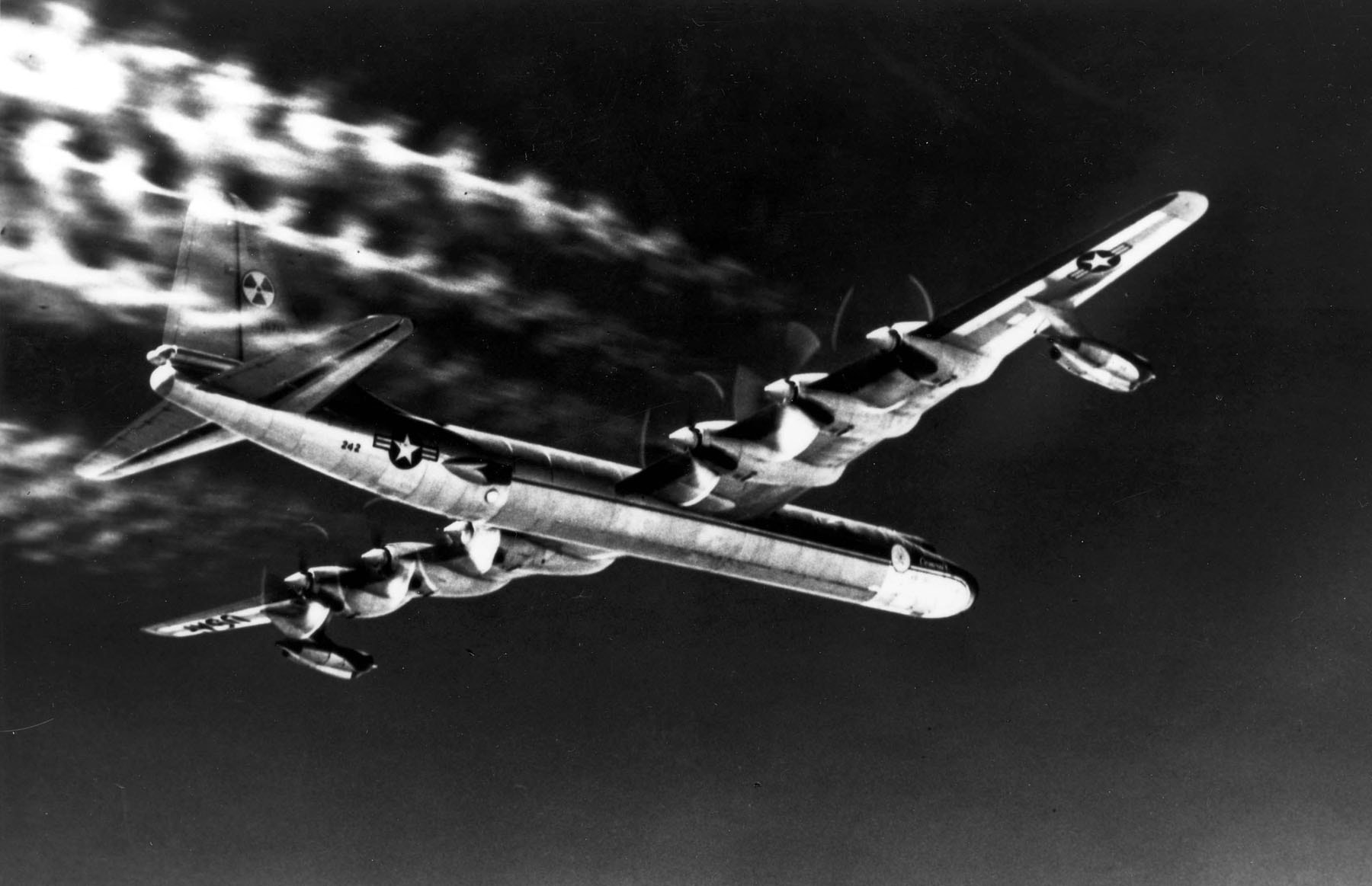B-36 Bomber: A Giant of the Cold War Era
The B-36 bomber, with its unprecedented size and range, transformed military aviation. Crucial during the Cold War, it showcased America’s air power. Discover what made the B-36 bomber a historic game-changer.
Key Takeaways
-
The B-36 Peacemaker, developed in response to WWII needs, became a pivotal long-range bomber for the U.S., capable of delivering nuclear payloads intercontinentally.
-
Despite never seeing combat, the B-36 served a crucial deterrence role during the Cold War, influencing strategic military calculations and future bomber designs.
-
The integration of jet propulsion in the B-36D model improved its performance significantly, showcasing adaptability in military aviation technology and setting the groundwork for advanced bomber aircraft.
B-36 Bomber: A Giant of the Cold War Era

By United States Air Force - USAF photo via, Joaobsen, Wagner, Greer (1980), B-36 Peacemaker in action - Aircraft No. 42, Squadron/Signal Publications; 1st edition, ISBN-10: 0897471016, Public Domain, https://commons.wikimedia.org/w/index.php?curid=18758427
In the early 1940s, as the world grappled with the devastating impacts of World War II, the United States Army Air Corps (USAAC) foresaw the need for a long-range bomber capable of striking targets deep within enemy territory. This foresight led to the conception of the Convair B-36 in 1941, a response to the potential fall of Britain and the ensuing need for extended bombing capabilities across Europe from North America. The B-36, developed by Consolidated Aircraft, later known as Convair, was envisioned to project American air power across vast distances, a revolutionary concept at the time.
The design and development of the B-36 were monumental undertakings. The aircraft featured a distinctive rearward-facing pusher configuration for its propellers, which enhanced airflow over its massive wings, a decision that underscored the innovative spirit of its designers. The first flight of the B-36 took place in August 1946, just a year after World War II ended, showcasing its capabilities and setting the stage for its entry into service in 1948.
As the largest mass-produced piston-engined bomber, the B-36 stood as a colossus among its peers. With over 380 units built before production ceased in 1954, it was a behemoth of the skies, unmatched in size and range. It could deliver nuclear weapons over intercontinental distances without refueling, making it a pivotal component of the United States’ strategic bombing arsenal during the early Cold War.
Despite its impressive capabilities, the B-36 never saw combat. Primarily, its role was one of deterrence, symbolizing the United States’ readiness to deploy overwhelming force if necessary. This deterrent role was critical during the tense standoffs of the Cold War, where the mere presence of such a formidable bomber could influence geopolitical calculations.
The influence of the B-36 extended beyond its operational years. The technological innovations it introduced, such as the integration of both piston and jet engines, set the groundwork for future military aviation designs. The design and operational strategies played a key role in developing subsequent generations of bomber aircraft, ensuring its legacy endured long after retirement.
Introduction
The B-36 Peacemaker, known as the largest bomber ever built by the United States, was initially designed during World War II but continued to see production and operational use well into the post-war period due to its unmatched long-range capabilities. This massive aircraft, with a wingspan rivaling that of a football field, became a symbol of American strategic air power during the early Cold War years. A total of 383 units were manufactured between 1947 and 1954, marking a significant chapter in military aviation history.
The B-36 was phased out by early 1959, giving way to advanced jet bombers like the B-52 Stratofortress. During its operational years, the B-36 played an indispensable role in maintaining strategic air power, crucial during the heightened tensions of the Cold War. Its retirement marked the end of an era, but its impact on military history remains significant.
This colossal bomber was not only a testament to American engineering but also a pivotal tool in the United States’ strategic arsenal. It could carry nuclear weapons over long distances from American soil to potential targets around the globe, making it a cornerstone of the United States’ deterrent strategy during global uncertainty. Exploring the B-36’s story reveals intricate details of its design, operational role, and the legacy it left in military history.
Development and Design
The B-36 bomber’s journey began in 1941, rooted in the dire circumstances of World War II. The USAAC needed a bomber capable of reaching Europe from North America if Britain were to fall, prompting the initial conception of the B-36. This vision led to the first designs emerging in early 1941, marking a monumental achievement in military aviation.
Designed by Consolidated Aircraft, the B-36 featured a rearward-facing pusher configuration for its propellers, enhancing airflow over the wings and improving aerodynamic efficiency. The B-36 represented a groundbreaking leap in aviation technology, showcasing the ingenuity and foresight of its designers.
The B-36’s first flight in August 1946 highlighted its capabilities and potential. By 1948, the B-36 was ready to strike targets up to 5,000 miles away, demonstrating its long-range capabilities. Though it never saw combat, this bomber was designed to project power over vast distances, crucial during the early Cold War.
With over 380 units completed before production ceased in 1954, the B-36 was the largest warplane produced by the United States. Its size and range capabilities influenced the design of later bombers and combat aircraft, showcasing the benefits of intercontinental range. Technological innovations like the combination of piston and jet engines set the groundwork for future military aviation designs.
The design and operational strategies of the B-36 played a key role in influencing future generations of bomber aircraft. Its legacy is evident in the advancements in military aviation that followed, reflecting the importance of its pioneering design and strategic concepts.
Jet Propulsion Integration

By United States Air Force - USAF photo via, Joaobsen, Wagner, Greer (1980), B-36 Peacemaker in action - Aircraft No. 42, Squadron/Signal Publications; 1st edition, ISBN-10: 0897471016, Public Domain, https://commons.wikimedia.org/w/index.php?curid=18756998
Initially, the B-36 relied solely on its six rear-facing propeller engines, which, while powerful, had limitations. With advancements in jet fighter speed and capabilities, the need for enhanced performance became apparent. This led to the integration of jet propulsion in the B-36D model, a significant upgrade to keep the aircraft competitive in a rapidly evolving aerial combat environment.
The B-36D was equipped with four General Electric J47 jet engines, mounted in jet pods under the wings, in addition to its six piston engines. This hybrid configuration dramatically improved performance, increasing the maximum speed to nearly 440 mph, a substantial enhancement over the B-36B’s 335 mph. This boost in speed was crucial for evading faster jet interceptors and ensuring the bomber’s survivability during long-range missions.
The integration of jet engines was not merely about speed. It enabled more efficient fuel consumption and better handling at higher altitudes. These improvements were essential for strategic bombing and reconnaissance missions, where long endurance and high-altitude performance were critical.
Adding jet engines reflected broader trends in aviation technology. Entering the jet age, the B-36’s hybrid propulsion system bridged the gap between piston-engine bombers and the all-jet bombers that would follow. This integration showcased the adaptability and forward-thinking approach of the aircraft’s designers, ensuring that the B-36 remained a formidable presence in the United States’ strategic arsenal.
Operational Role in Strategic Air Command

Public Domain, https://commons.wikimedia.org/w/index.php?curid=1682606
The B-36 Peacemaker played a pivotal role within the Strategic Air Command (SAC), serving as a cornerstone of the United States’ strategic bombing capabilities during the early Cold War. The SAC first received operational B-36s in June 1948, marking the bomber’s formal entry into military service and signaling a new era in strategic air power. This aircraft was designed to deliver nuclear weapons across vast distances, a task that became increasingly important as Cold War tensions escalated.
Its ability to carry heavy payloads over intercontinental flight distances without refueling made it a critical component of the United States’ nuclear deterrent strategy. It was the main aircraft for delivering nuclear weapons until the introduction of the B-52 Stratofortress in 1955. This role underscored the B-36’s importance in maintaining a credible threat against potential adversaries, particularly the Soviet Union.
Operational deployments were extensive, with the B-36 stationed at various strategic locations, including Carswell Air Force Base (AFB) in Texas, a central hub for B-36 operations. Adding jet engines to the B-36D variant was a response to the need for faster aircraft to counter advancements in jet fighter technology, which saw speeds increase to 500 mph. Despite challenges, the B-36 maintained a remarkable operational ceiling, keeping it out of range of many interceptors.
The role of the B-36 in the Strategic Air Command was complex. It balanced strategic bombing responsibilities with reconnaissance missions, providing valuable intelligence on Soviet military capabilities. This dual role highlighted the B-36’s versatility and strategic importance within the United States Air Force.
As the B-36 transitioned out of service, it paved the way for the next generation of strategic bombers. Lessons learned from its deployment and the innovations it introduced had a lasting impact on subsequent aircraft design and operational strategies, ensuring its legacy endured long after retirement.
Reconnaissance Missions
In addition to its strategic bombing role, the B-36 was also adapted for reconnaissance missions, an essential function during the Cold War. Some variants of the B-36 were modified to become RB-36s, specifically designed for photo-reconnaissance. These aircraft had enhanced camera compartments for multiple high-resolution cameras, boosting their intelligence-gathering capabilities.
The RB-36 variants repurposed the forward bomb bay to house a pressurized camera compartment, capturing detailed imagery from high altitudes. These missions were crucial for gathering intelligence on Soviet military capabilities, providing valuable data that informed national security strategies and helped maintain a strategic advantage.
Challenges and Criticisms

By United States Air Force Historical Research Agency, Maxwell AFB, Alabama, transferred from en.wikipedia, Public Domain, https://commons.wikimedia.org/w/index.php?curid=3709951
Despite its numerous strengths, the B-36 Peacemaker faced challenges and criticisms. One significant issue was engine reliability. The pusher configuration made the B-36’s engines particularly susceptible to overheating. This often led to inflight engine failures, contributing to the perception of the aircraft being problematic and unreliable.
The B-36 procurement process also faced intense scrutiny. Allegations of collusion and favoritism prompted a Congressional investigation. However, a 1949 House Armed Services Committee investigation ultimately found no evidence of misconduct in the procurement process, clearing the project of any wrongdoing.
Naval advocates labeled the B-36 as slow and overly vulnerable to enemy defenses. This criticism was part of a broader Navy campaign to undermine the B-36 while promoting their supercarrier initiative. The rivalry between the Air Force and the Navy highlighted the strategic debates of the time, with each branch vying for dominance in national defense roles.
Despite these challenges, the Air Force maintained the B-36 was essential for delivering atomic bomb weapons, especially during the late 1940s tensions. Enhancements, like adding jet engines, responded to the development of more powerful hydrogen bombs, necessitating faster escape speeds from nuclear detonations.
Operating at altitudes up to 50,000 feet allowed the B-36 to evade most Soviet air defenses, reinforcing its strategic value.
Notable Incidents and Accidents
The operational history of the B-36 included several notable incidents and accidents, some significantly impacting its reputation. In 1950, a B-36 crashed due to electrical malfunctions caused by recoil vibrations during gun practice, contributing to the perception of safety issues.
In 1952, a tornado struck Carswell Air Force Base, damaging a B-36. The damaged aircraft was later modified to become a nuclear reactor testbed, showcasing the B-36’s adaptability and continued utility.
Despite these incidents, overall safety records indicate the B-36 was a robust aircraft designed to withstand challenging operational environments. These incidents, while unfortunate, did not overshadow the B-36’s contributions to strategic air power. They highlighted the inherent risks and operational challenges of such a complex and advanced military aircraft, which was one of the only aircraft of its kind.
Lessons from these incidents played a crucial role in improving the safety and reliability of subsequent bomber designs.
Technical Specifications
The B-36 was an engineering marvel, featuring impressive technical specifications that underscored its capabilities as a strategic bomber. It boasted a wingspan of 230 feet and was powered by six rear-facing propeller engines, marking a significant advancement in aviation technology. The B-36J-III model measured 162.1 feet in length, had a wingspan of 230 feet, an empty weight of 166,165 pounds, and a maximum takeoff weight of 410,000 pounds.
Powered by ten engines, including six Pratt & Whitney Wasp Major radial engines in a pusher configuration and four General Electric J47 turbojet engines mounted under the wings, the B-36J-III could achieve a maximum speed of 375 knots at an altitude of 38,000 feet. By 1949, some B-36 models could reach speeds of 435 mph and had an operational range of up to 12,000 miles, reflecting its capability for extended missions.
The B-36’s offensive capabilities were equally impressive, with a maximum bomb load capacity of 72,000 pounds carried in four bomb bays. For defensive measures, it was equipped with two M24A1 20 mm autocannons in a tail turret.
Its combat radius was approximately 3,465 nautical miles with a bomb load of 10,000 pounds, making it a formidable presence in the skies. These specifications highlight the B-36’s role as a strategic powerhouse, capable of delivering significant payloads over vast distances.
Legacy and Impact

By Unknown author - http://www.nationalmuseum.af.mil/photos/media_search.asp?q=nb-36H&btnG.x=0&btnG.y=0direct link to the picture: http://www.nationalmuseum.af.mil/shared/media/photodb/photos/060720-F-1234S-021.jpg, Public Domain, https://commons.wikimedia.org/w/index.php?curid=3848038
The legacy of the B-36 Peacemaker extends far beyond its operational years, leaving an indelible mark on military doctrine and the development of aerial warfare. As a symbol of Cold War military power, the B-36 represented significant advancements in strategic bombing capabilities, influencing military strategies and doctrines for years to come.
Public interest in the B-36 grew during the Cold War, establishing it as a cultural icon depicted in media and popular culture. Its massive size and distinctive design captured the imagination of the public, reinforcing its status as a symbol of American air power. The B-36 is now represented in museums, where it stands as a testament to the technological and strategic achievements of its time.
The B-36’s final operational flight took place in 1959, after which the aircraft was preserved in museums, ensuring its legacy would be remembered. These preserved aircraft serve as educational tools, providing insight into the history of military aviation and the pivotal role the B-36 played during a critical period in global history.
The B-36 Peacemaker’s impact on the development of subsequent bomber aircraft cannot be overstated. Its innovative design and strategic concepts influenced the creation of later models, paving the way for a new generation of strategic bombers. The lessons learned from the B-36’s development and deployment continue to inform military aviation practices, ensuring that its legacy endures.
Summary
The B-36 Peacemaker was more than just a bomber; it was a symbol of American ingenuity and strategic power during the Cold War. From its conception during World War II to its role in the Strategic Air Command, the B-36 represented a significant leap in military aviation technology. Its innovative design, combining piston and jet engines, and its ability to carry nuclear weapons over vast distances made it a cornerstone of the United States’ strategic arsenal.
As we reflect on the B-36’s legacy, it is clear that this aircraft played a crucial role in shaping the future of military aviation. The technological advancements and strategic concepts it introduced have had a lasting impact, influencing the design and deployment of subsequent generations of bombers. The B-36 Peacemaker remains a testament to the power of innovation and the enduring importance of strategic air power in maintaining national security.
Frequently Asked Questions
What was the B-36's primary role?
The B-36 served primarily as a strategic bomber for the United States Air Force, intended for delivering nuclear weapons across intercontinental distances during the early Cold War.
How many B-36 bombers were built?
A total of 383 B-36 Peacemakers were built between 1947 and 1954.
What were some of the B-36's unique features?
The B-36's unique features included its rearward-facing pusher propellers, an impressive wingspan of 230 feet, and the innovative use of both piston and jet engines, which greatly improved its operational performance.
Why was the B-36 criticized?
The B-36 was criticized for its unreliable engines, overheating problems, and perceived vulnerabilities to enemy defenses, along with concerns regarding the procurement process. These factors led to significant skepticism about its effectiveness in combat situations.
Where can I see a B-36 today?
You can see a B-36 at the National Museum of the United States Air Force, which highlights its historical significance and technological advancements.

By USAF Photo - http://www.nationalmuseum.af.mil/photos/media_search.asp?q=b-36&page=4 direct link to the picture:http://www.nationalmuseum.af.mil/shared/media/photodb/photos/060720-F-1234S-012.jpg, Public Domain, https://commons.wikimedia.org/w/index.php?curid=6408270

By United States Air Force - USAF photo via, Joaobsen, Wagner, Greer (1980), B-36 Peacemaker in action - Aircraft No. 42, Squadron/Signal Publications; 1st edition, ISBN-10: 0897471016, Public Domain, https://commons.wikimedia.org/w/index.php?curid=18757164
Featured Image By Leoparmr - Own work, CC BY-SA 4.0, https://commons.wikimedia.org/w/index.php?curid=35541566







